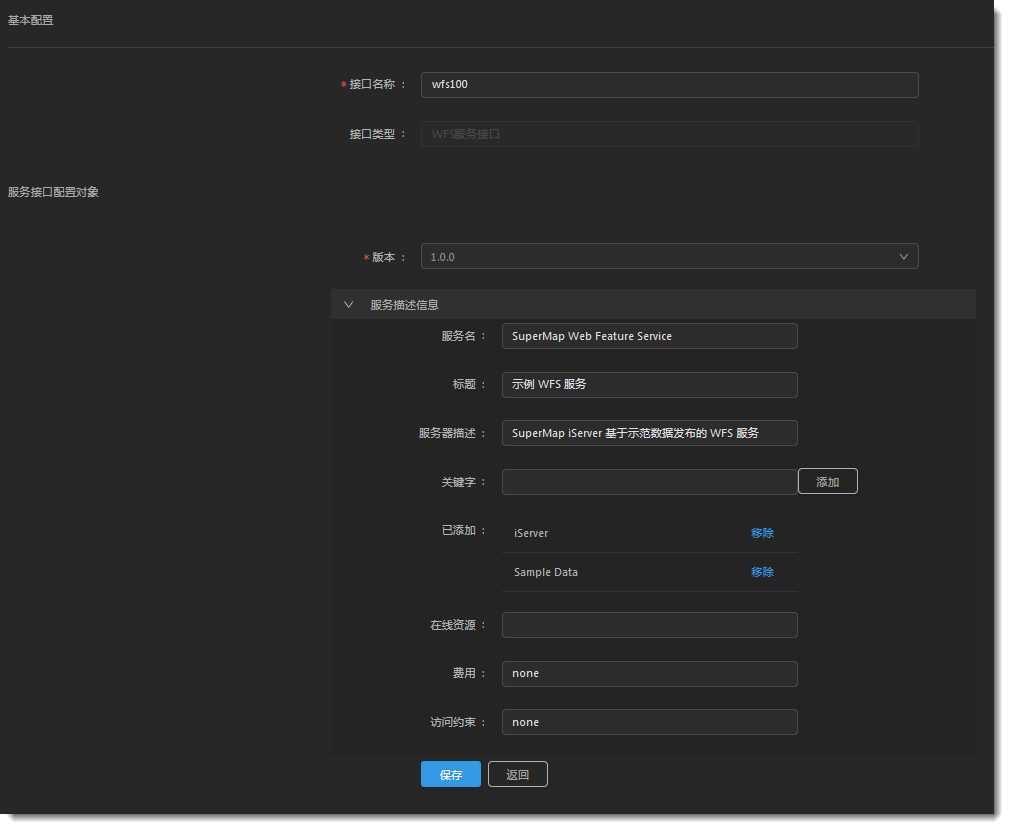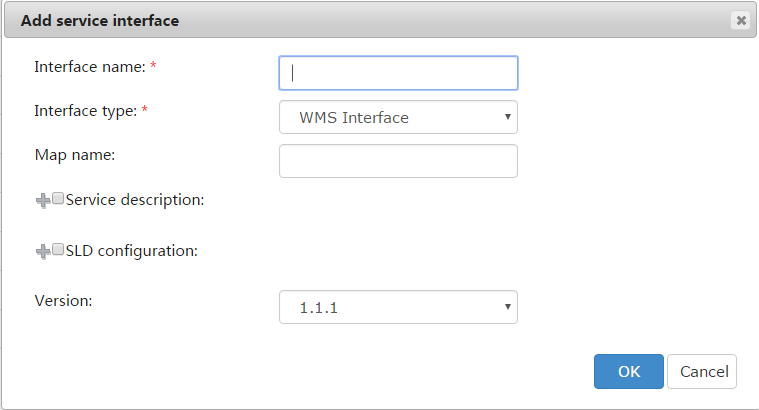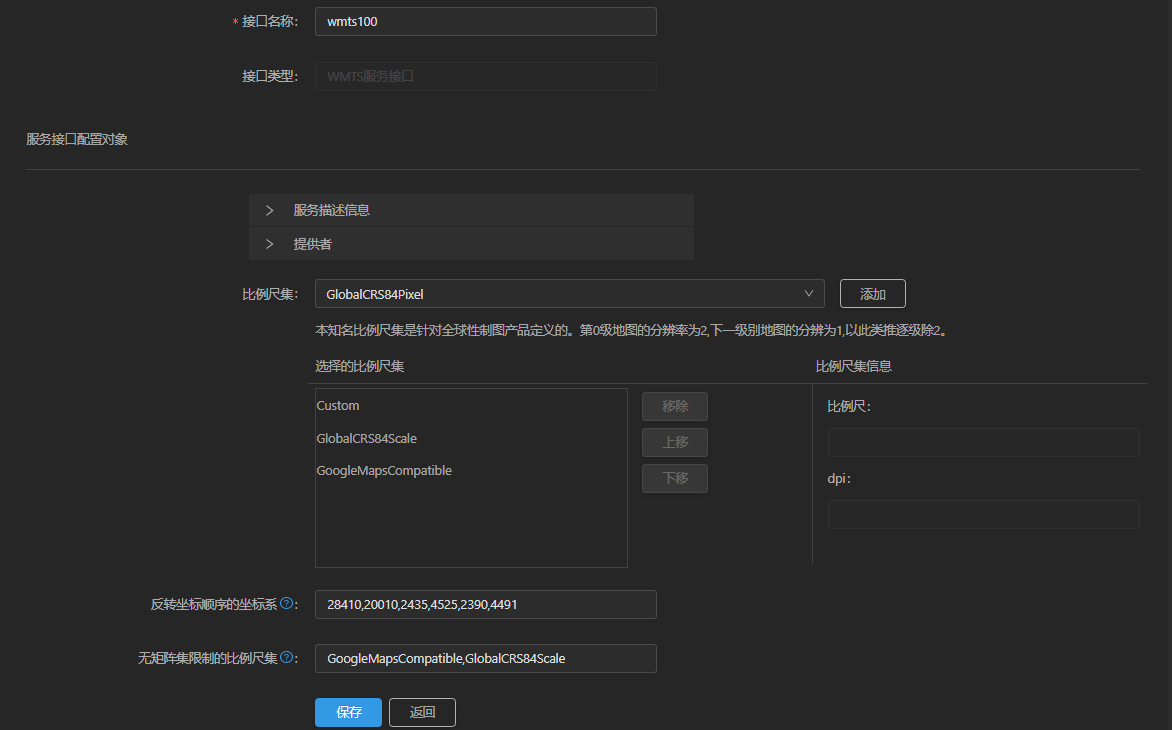
SuperMap iServer not only provides standard WMS (Web Map Service) interfaces, WFS (Web Feature Service) interfaces, WMTS (Web Map Tile Service) interfaces, WCS (Web Coverage Service) interfaces REST service interface and REST/JSR (REST Spatial Analysis) service interface, as well as allowing users to customize interface types. Currently, SuperMap iServer supports WMS 1.1.1 and 1.3.0 versions, WFS 1.0.0 and 2.0.0 versions, WMTS 1.0.0 version, WCS 1.1.1 and 1.1.2 versions.
On the service interfaces page, users can add new service interfaces, modify existing service interfaces, or delete a certain service interface. In the service page, * is used to indicate required parameters, and the user must provide the parameter values of such parameters.
The operations of service interfaces are described in detail below.
When adding custom interface types, it is necessary to set meta information resource aliases, meta information resource type names, and meta information resource configuration class names. These three are all required parameters, where the meta information resource alias refers to the alias of the resource class, the meta information resource type name refers to the name of the implementation class of the user-defined interface type, and the meta information resource configuration class name refers to the name of the configuration class of the user-defined interface type. For custom interface types, users need to provide the configuration information of the interface in the form of a JSON string.
Parameters such as interface name and interface type need to be set.
Add WFS service interfaces.
In addition to setting the interface name and interface type, the WFS service supports user-defined identification, as shown in the following figure:

In addition, the WFS 2.0.0 service also supports custom providers and contact information.
In addition to setting interface name and interface type, map name, identification and version information should also be specified, among which interface name and interface type are required parameters. WMS The map name in the service can be any map name in the workspace, and the default map name is the first map name of the workspace. Therefore, the user needs to be clear about the map name and order in the workspace; The identification is the information used to describe the service, including the service name, title, server description, keywords, online resource, cost, access constraints, etc.; SLD (Styled-Layer Descriptor) configuration information is used to configure the layer style for the WMS service. For how to use SLD in iServer, see Using SLD , iServer currently supports SLD in WMS 1.1.1, and can configure point, line, surface, and text layers; version parameter: SuperMap iServer 11 I (2024) currently supports WMS 1.1.1 and WMS 1.3.0, and users can choose the appropriate version according to their needs.
The following is an example of adding a WMS service interfaces. After setting the parameters, click OK to complete the addition of this interface. The service interfaces added by the user will be displayed on the homepage of service interfaces.

In addition to setting interface name and interface type, parameters such as service identification information, service providers information, and scale set information (scale information, screen resolution (DPI)) are also specified. interface name、interface type Is a required parameter. The service identification information includes service title, description, keywords, fee, access restriction, service type, service type version, etc. The service provider information includes provider name, website, service contact information, etc. The well-known matrix set parameter I Universal matrix set defined by WMTS standard, with seven optional values: GlobalCRS84Scale, GlobalCRS84Pixel, GoogleMapsCompatible, GoogleCRS84Quad , ChinaPublic Services, ChinaPublic Service sCGCS2000, and Custom. See WellknownScale for details . SuperMap The iServer supports the user to set the custom scales set in the WMTS interface.
Here, the scale on which the SuperMap iServer WMTS service is based is defined by the following formula: scale = 1: ground resolution (a) * screen resolution (dpi)/0.0254 (m/ft) . Ground resolution (a) is the actual ground distance represented by a pixel in meters, and screen resolution (dpi) is the number of pixels per inch of screen length, such as 96 dpi Represents 96 pixels per inch; 0.0254 (meters per foot) refers to the unit conversion of meters to inches. The common matrix set in the WMTS standard is defined based on a pixel size of 0.28 mm, from which the number of pixels per inch can be inversely calculated, that is, The dpi value. It can be seen that for the specified data, the scale will be different due to different dpi under different resolutions, so DPI is an important parameter to determine the scale, which needs to be specified when creating a new WMTS interface.
In addition, SuperMap iServer also provides advanced settings such as a coordinate system with reversed coordinate order and a scale bar set without matrix set restrictions, to ensure that WMTS services can browse or adjust their browsing effects correctly. Among them, the coordinate system setting for reversing the coordinate order is used to specify the EPSG encoding of the coordinate system that needs to reverse the coordinate order of LowerCorner and UpperCorner in BoudingBox; The scale set without matrix set restrictions is used to specify a scale set without TileMatrixSetLimits, in order to remove the mapping range restrictions under a certain scale set.
When the user creates a new WMTS interface, select Custom for the matrix set. If the dpi is not set, the Custom specified in the WMTS 1.0.0 standard is used. Dpi, the value of dpi when the pixel size is 0.28 mm. If custom scales is set, the scale bar parameter refers to the denominator of the scale bar, and no special description will be made below.
In order to comply with the map classification regulations in the "Electronic Map Data Specification for Geographic Information Public Service Platform" issued by the National Administration of Surveying, Mapping and Geoinformation, SuperMap iServer provides an extended instance "wmts china" based on the WMTS interface, which is used to provide tile map services based on the commonly used domestic map classification method. The wellKnownScaleSet needs to be set to ChinaPublicServices, and the scale bar set is shown in the table below, with a corresponding dpi of 96. It should be noted that the wmts china interface only supports 4326 coordinate system and data sources that support default dynamic projection.
| Level | Ground resolution (m/pixel) | Displays the scale bar |
| 1 |
78,271.5170 |
1:295,829,355.45 |
| 2 | 39,135.7585 | 1:147,914,677.73 |
| 3 | 19,567.8792 | 1:73,957,338.86 |
| 4 | 9,783.9396 | 1:36,978,669.43 |
| 5 | 4,891.9698 | 1:18,489,334.72 |
| 6 | 2,445.9849 | 1:9,244,667.36 |
| 7 | 1,222.9925 | 1:4,622,333.68 |
| 8 | 611.4962 | 1:2,311,166.84 |
| 9 | 305.7481 | 1:1,155,583.42 |
| 10 | 152.8741 | 1:577,791.71 |
| 11 | 76.4370 | 1:288,895.85 |
| 12 | 38.2185 | 1:144,447.93 |
| 13 | 19.1093 | 1:72,223.96 |
| 14 | 9.5546 | 1:36,111.98 |
| 15 | 4.7773 | 1:18,055.99 |
| 16 | 2.3887 | 1:9,028.00 |
| 17 | 1.1943 | 1:4,514.00 |
| 18 | 0.5972 | 1:2,257.00 |
| 19 | 0.2986 | 1:1,128.50 |
| 20 | 0.1493 | 1:564.25 |
SuperMap iServer also provides an extension instance "wmts-arcgis" based on the WMTS interface, which is used to provide compatibility after shielding personalized differences. ArcGIS products release tilemap services for WMTS services. By default, the coordinate system with reversed coordinate order includes EPSG codes of 28410, 20010, 2435, 4525, 2390, and 4491 Several coordinate systems, tile matrix set without tile matrix set limits include well-known matrix sets such as GoogleMapsCompatible and GlobalCRS84 Scale by default.
See the figure below for the setting mode of relevant parameters of the above WMTS. For the parameter setting of wmts-china, the default is the domestic common Web For map settings, it is recommended to use the default value, such as dpi.

The configuration of service interfaces includes the following two aspects: basic configuration and interface object configuration.
For WMS services, users can modify the interface name, map name, identification, and version information used by the interface. Note: The user can reset the name of the published map name by modifying the map name.
For WMTS service, the user can modify the interface name, generic matrix set, identification information, and service provider information. See Adding WMTS Service Interface .
For REST service interfaces, REST/JSR service interfaces, ArcGIS rest interface, Baidu rest interface, Google, REST service interfaces1 and WPS service interfaces, the user can only modify the name of the interface.
For WFS service, the user can modify the interface name and the version information used by the interface.
For WCS service, the user can modify the interface name, the version information used by the interface, and the service identification information.
You can delete one or more service interfaces from the service providers list:
1.Select one or more service interfaces to delete
2.Click the "Delete" button
3.Click "Yes" in the pop-up confirmation dialog box
Note 1: Use ArcGIS REST, Baidu in iServer REST, Google REST service interfaces, need to purchase iServer Advanced, iEdge can be used directly.